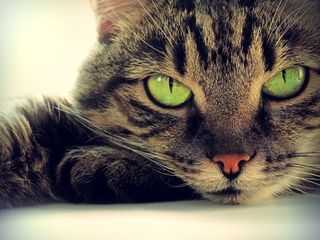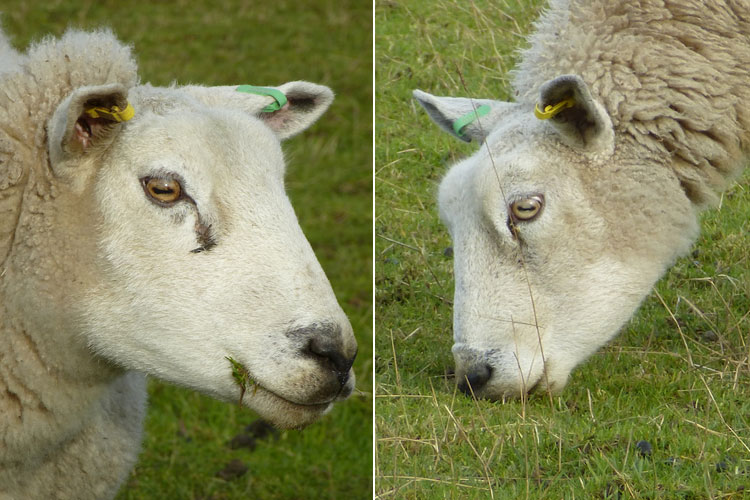What Animal Does Not Have Spherical Or Vertically Slit Pupils
Why Cats Take Vertical Pupils

Have yous always wondered why your true cat'south eyes accept those creepy vertical slits for pupils? A new study suggests the reason may lie in cats' preferred style of hunting.
Vertical-slit pupils are nearly common amongst nocturnal predators that ambush their casualty, co-ordinate to the new enquiry, published today (Aug. seven) in the journal Science Advances. Near likely, this pupil shape provides the sharpest way to gauge distance for a prey-snatching leap, the study establish.
The new enquiry doesn't only demystify the housecat, nevertheless; it too reveals that the bizarre horizontal, rectangular pupils sported past goats and sheep likely assist these prey animals scan the horizon for predators — and watch the terrain when sprinting from danger. Moreover, circular pupils tend to be plant on tall, active predators that are awake during the day. (Sound familiar, humans?) [Video: Why Goats Take Rectangle Optics]
Cat'southward eye
The observation that predators tend to have vertical pupils and prey horizontal ones dates back to the 1940s, but no ane had e'er quantified that divergence, said Martin Banks, a vision researcher at the University of California, Berkeley. To find out if there was truth behind the casual observations, Banks and his squad assembled a database of 214 country-based species. And then, they analyzed the pupil shape of each species in relation to the animal's foraging habits and day or nighttime action. (The team left out birds and fish in order to limit the complications of varying visual environments.)
Ambush predators, similar many cats and snakes, were most probable to sport vertical-slit pupils, particularly when those animals were active at night. The reason for this correlation most likely has to do with the mechanics of the centre, Banks told Live Science. Deadfall hunters need to be very proficient at gauging depth so they can effectively leap out at their prey.
There are 2 means to gauge depth without moving. In one method, stereopsis, the brain compares the distance betwixt the ii images returned past each centre to gauge depth. (Hold out your finger, focus on it and close each eye in succession. That "leap" yous meet is the altitude used in stereopsis.) [Images: Run across the World From a Cat's Eye]
The other method, mistiness, takes reward of the fuzziness of objects behind and in front of the spot on which you're focusing.
As it turns out, the side-to-side displacement used in stereopsis is easier to gauge using vertical lines and contours than information technology is with horizontal ones. Thus, Banks said, the vertical pupil provides the all-time view for stereopsis.
To judge horizontal distances, though, cats and other slit-educatee predators likely use blur, Banks said. To maximize blur, the pupil must open up wide. And to maximize blur for horizontal lines, the pupil must open broad from acme to lesser. In other words, the ideal shape is narrow horizontally and wide vertically — precisely the arrangement of a cat's eye.
"This is the right arrangement to maximize stereo and blur as cues to altitude simultaneously," Banks said.
Pupils for casualty
On the other side of the spectrum are the weird rectangular pupils of goats, sheep, horses and some toads. Banks and his colleagues found that, of 42 herbivorous prey animals in their database, 36 had horizontal pupils. To notice out why, they created a computer model of a sheep'due south eye and measured its eyes. [Vision Quiz: What Tin Animals Run across?]

The results revealed that a horizontal pupil minimizes input from higher up and below, and maximizes input from the front and back of an animate being, creating a panoramic view. Plus, most of these casualty animals have eyes on the sides of their heads, farther improving that view.
"It allows them to run across better in forepart and backside, and maybe not to be dazzled by sunlight from to a higher place," Banks said.
Fifty-fifty more than interesting, Banks said, was the discovery that these pupils also minimize the mistiness of horizontal contours, creating a sharper paradigm of the ground and upcoming terrain. That'southward pretty important for an animal that might demand to drop everything and run if a mount king of beasts pounces — especially an animal with its eyes on the side of its head, Banks said.
"Imagine your eyes were looking 70 degrees [off] from where you're running," he said. "Yous'd exist terrible at information technology."
Partway through developing this theory, Banks and his colleagues realized they might have a problem, he said. A caprine animal'southward horizontal eyes would have to stay in line with the horizon for the fauna to do good from this boosted clarity. If the fauna's pupils didn't line upwards when it was grazing, head down, "there goes our idea," Banks said.
He "dashed off" to a local zoo while 1 of his colleagues headed to a farm nigh his habitation in England, each with a video photographic camera in hand. What they saw put their theory back in the game: Goats, sheep and horses all rotate their eyes — one clockwise and one counterclockwise — to keep their pupils in line with the horizon when grazing.
Banks could find no reference to this talent in the scientific literature but said he and his team "kind of doubtfulness" they discovered it. "I can't imagine that this missed everyone'southward attention for the last couple hundred years," he said.
Eye evolution
If vertical pupils are for hunting and horizontal pupils are for fleeing, where does that leave circular pupils like the ones humans have? Those results, Banks said, are a bit less clear. Animals with round pupils tend to be active predators or foragers that are awake both 24-hour interval and night. Merely the correlation between pupil shape and these traits was non as strong every bit it was for vertical and horizontal pupils.
Finally, the researchers created some family trees of cats and canids (a grouping that includes dogs and foxes), to find out whether pupil shape evolved only once in these families or whether it pops upwards independently on multiple occasions. They constitute that foreign pupil shapes have evolved many times.
"It's just kind of come and gone depending on their niche," Banks said. "We think that whatever pressure there was to evolve a certain pupil shape happened multiple times, non just one time."
Distance judgments aren't the only reason animals might evolve a certain student shape, Banks added. Other factors, such as color vision and pattern recognition, probably play a role.
The researchers now want to study the interaction between the retina and the educatee, particularly in horizontal optics. Many animals with horizontal pupils have a "smear" retina, Banks said, with higher densities of calorie-free receptors in a horizontal streak across the retina. (Humans, by contrast, have a circular area called the fovea that is particularly dense.)
The squad also wants to look at fifty-fifty odder optics. Some lizards, for example, have pupils that narrow into three or four vertically stacked pinholes. Cephalopods similar cuttlefish have truly bizarre, "Due west"-shaped pupils. And some skates and rays have pupils shaped like crescent moons.
"In that location are a lot of actually weird ones out there," Banks said.
Follow Stephanie Pappas on Twitter a nd Google+ . Follow us @livescience , Facebook & Google+ . Original commodity on Live Science.
Source: https://www.livescience.com/51787-why-cats-have-vertical-pupils.html
Posted by: stephenbuslow.blogspot.com

0 Response to "What Animal Does Not Have Spherical Or Vertically Slit Pupils"
Post a Comment